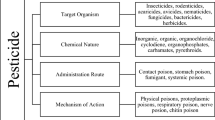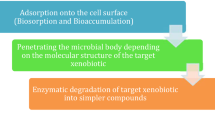Abstract
Biodegradation of endosulfan (α and β) and pendimethalin by Bacillus safensis strain FO-36bT, Bacillus subtilis subsp. inaquosorum strain KCTC 13429T and Bacillus cereus strain ATCC14579T isolated from pesticides-polluted soil was studied in mineral salt medium. Endosulfan and pendimethalin were incubated with the three bacterial strains with samples drawn at various intervals for GC analysis. Representative samples were subject to GC–MS analysis. The loss in the initial concentrations, 0.663 mM (α endosulfan), 0.319 mM (β endosulfan) and 1.423 mM (pendimethalin), was monitored and used to compute the half-lives following biphasic model. Removal percentage of endosulfan and pendimethalin in the media inoculated with the bacterial strains ranged from 24 to 95% (α endosulfan), 21–91% (β endosulfan) and 51–97% (pendimethalin), respectively. Despite the significant decrease in starting material in B. safensis cultures, no metabolites were detected, whereas two major metabolites of endosulfan, 1,2,3,4,7,7-hexachloro-5,6-dihydroxybicyclo{2.2.1}-2-heptene and 1,2,3,4,7,7-hexachloro-formaldehyde-6-methylbicyclo{2.2.1}-2-heptene, were detected in the B. subtilis cultures, and one metabolite of pendimethalin metabolite; N-(1-ethylpropyl)-3-methyl-2, 6-diaminobenzine, was detected in the B. cereus culture. Generally, the result indicates the potential capability of these microorganisms in complete mineralization of endosulfan and pendimethalin. Based on half-lives, the efficiency of bacterial strains can be ordered as follows: B. subtilis > B. cereus > B. safensis for endosulfan and B. cereus > B. safensis > B. subtilis for pendimethalin.




Similar content being viewed by others
References
Abdelbagi AO, Elmahi MA, Osman DG (2000) Chlorinated hydrocarbon insecticide residues in the Sudanese soils of limited or no pesticide use. Arab J Plant Protect 18:35–39
Abdelbagi AO, Elmahi MA, Osman DG (2003) Organochlorine insecticides residues in sudanese soils of intensive pesticide use and in surface soil of Qurashi pesticide store. UK J Agric Sci 11:59–68
Butrous (1999) Evaluation and assessment of obsolete and banned pesticides in five agricultural schemes. Report, 83–89, Sudan
Abubaker OAW (2007) Level and movement of pesticide contaminants in the dangerous area of Port Sudan Harbour and their impact on human and aquatic life. Dissertation, University of Khartoum
Babiker M (1998) Levels and movement of some pesticides in Qurashi store area. Hessahisa province, central Sudan, Dissertation, University of Khartoum
Abdelbagi AO, Mohamed AA (2006) Pesticide residues in the Sudanese environment. In: Proceedings of a national workshop on measures for import, storage, handling and use of pesticides and fertilizers. Friendship Hall, Khartoum, Sudan. Organized by the Sudanese Standards and Metrology Organization, Khartoum. Sudan. Aug 2007. pp 66–118
Environmental Protection Agency (EPA) (1999) Persistent bioaccumulative toxic (PBT) chemicals. Final Rule, Fed. Regist 64, 58666 58753
Meister RT (1992) Farm chemicals handbook ‘92. Meister Publishing Company, Willoughby
Environmental Protection Agency (1992) National study of chemical residues in fish: U.S. environmental protection agency, office of science and technology, EPA- 823-R-92-008b, v. 2, variously paged. Appendix 115
Ritter L, Solomon KR, Forget J, Stemeroff MO, Leary C (2007) Persistent organic pollutants: an assessment report on: DDT, aldrin, dieldrin, endrin, chlordane, heptachlor, hexachlorobenzene, mirex, toxaphene polychlorinated 13 biphenyls. Dioxins and furans, Prepared for The International Programme on Chemical Safety (IPCS)
Guerin TF (1999) The anaerobic degradation of endosulfan by indigenous microorganisms from low oxygen soils and sediments. Environ Pollut 106:13–21
Shivaramaiah HM, Kennedy IR (2006) Biodegradation of Endosulfan by soil bacteria. J Enviorn Sci Health B 41:895–905
Siddique T, Okeke BC, Arshad M, Frankenberger WT (2003) Enrichment and isolation of endosulfan-degrading microorganisms. JEQ 32:47–54
Shetty PK, Mitra J, Murthy NBK, Namitha KK, Sovitha KN, Raghu K (2000) Biodegradation of cyclodiene insecticide endosulfan by Mucor thermo---hyalospora MTCC 1384. Curr Sci 79:1381–1383
Elmahi MA (1996) Distribution of chlorinated hydrocarbon pesticides residues in Sudan soil. M.Sc. Dissertation, University of Khartoum
Ali TM (2005) Naturally occurring soil microorganism in qurashi pesticides store and the surrounding Gezira soil areas and their potential in degrading Endosulfan α, β and lindane. Dissertation, University of Khartoum
Elsaid OG, Abdelbagi AO, Elmustafa EA (2010) Microbial degradation of endosulfan in carbon free media and selective media. Res J Agric Biol Sci 6(3):257–562
Elsaid OG, Abdelbagi AO, Elsheikh EAE (2009) Effects of fertilizers (activators) in enhancing microbial degradation of endosulfan in soil. Res J Environ Toxicol 3(2):76–85
Elsaid OG, Abdelbagi AO (2010) Comparative biodegradation of endosulfan by mutant and their native microorganisms. Res J Agric Biol Sci 6(6):953–961
Shaer IBS, Abdelbagi AO, Elmustafa EA, Ahmed SAI, Osama GE (2013) Biodegradation of pendimethalin by three strains of bacteria isolated from pesticides polluted soils. U K J Agric Sci 21(2):233–252
Ishag ASA, Abdelbagi AO, Hammad AMA, Elmustafa EA, Osama EE, Hur J-H, Laing MD (2016) Biodegradation of chlorpyrifos, malathion, and dimethoate by three strains of bacteria isolated from pesticide-polluted soils in Sudan. J Agric Food Chem 64:8491–8498
Barrow GI, Feltham RKA (2003) Cowan, and steel’s manual for identification of medical bacteria, 3rd edn. Press Syndicate of the University of Cambridge, Cambridge, p 317
Thompson R, Marcelino A, Polz F (2002) Heteroduplexes in mixed-template amplifications: formation, consequence and elimination by ‘reconditioning PCR’. Nucleic Acids Res 30(9):2083–2088
Tepper EZ, Shilnikova VK, pereverzeva GI (1994) A manual of Microbiology (In Russian), 4th Edition, kolas Publishers Moscow. 170 p
Gi-Seok K, Ho-Yong S, Kee-Sun S (2005) Biodegradation of the organochlorine insecticide, endosulfan, and the toxic metabolite, endosulfan sulfate, by Klebsiella oxytoca KE-8. Appl Microbiol Biotechnol 67:845–850
Mathava K, Ligy P (2006) Endosulfan mineralization by bacterial isolates and possible degradation pathway identification. Bioremediat J 10(4):179–190
Abdurruhman MA, Abdelbagi OA, Ahmed ASI (2015) Biodegradation of pendimethalin and atrazine by Pseudomonas pickettii isolated from pesticides polluted soil under laboratory conditions. J Biotechnol Sci Res 2(3):94–102
El Zorgani GA (1982) The status of DDT residues in Sudan. Progress report. Agricultural Research Corporation, Wad Medani, Sudan
Kole RK, Saha J, Pal S, Chaudhuri S, Chowdhury A (1994) Bacterial degradation of the herbicide pendimethalin and activity evaluation of its metabolites. Bull Environ Contam Toxicol 52:779–786
Thangadurai P, Suresh S (2014) Biodegradation of endosulfan by soil bacterial cultures. Int. Biodeterior. Biodegrad 94:38–49
Byeoung-Soo P, Sung-Eun L (2004) Biotransformation of endosulfan by Anabaena sp. PCC 7120. Agric Chem Biotechnol 47(1):38–41
Singh SB, Kulshrestha G (1991) Microbial degradation of pendimethalin. J. Environ Sci Health B26:309–321
Ulčnik A, Kralj CI, Pohleven F (2013) Degradation of lindane and endosulfan by fungi, fungal and bacterial laccases. World J Microbiol Biotechnol 29(12):2239–2247
Megadi VB, Tallur PN, Hoskeri RS, Mulla SI, Ninnekar HZ (2010) Biodegradation of pendimethalin by Bacillus circulans. Indian J Biotechnol 9:173–177
Okerentugba PO, Ezeronye OU (2003) Petroleum degrading potentials of single and mixed microbial cultures isolated from rivers and refinery effluent in Nigeria. Afr J Biotechnol 2(9):288–292
Elsaid OG, Abdelbagi AO, Elsheikh EAE (2011) Accelerating the rate of endosulfan degradation by bacteria and actinomycetes. Int J Appl Environ Sci 6(1):11–21
Singh PB, Sharma S, Saini HS, Chadha BS (2009) Biosurfactant production by Pseudomonas sp. and its role in aqueous phase partitioning and biodegradation of chlorpyrifos. Lett Appl Microbiol 49:378–383
Khaled AO, Gamal HI, Ahamed IA, Abdul Rahman AA (2008) Biodegradation kinetics of dicofol by selected microorganisms. J Pest Biochem Physiol 91:180–185
Rigas F, Papadopoulou K, Dritsa V (2007) Bioremediation of a soil contaminated by lindane utilizing the fungus Ganoderma austral via response surface methodology. J Hazard Mater 140(1–2):325–332
Awasthi N, Manikam N, Kumar A (1997) Biodegradation of endosulfan by a bacterial co-culture. Bull Environ Contam Toxicol 59:928–934
Jesitha K, Nimisha KM, Manjusha CM, Harikumar PS (2015) Biodegradation of endosulfan by Pseudomonas fluorescens. Environ Process 2(1):225–240
Kullman SW, Matsumura F (1996) Metabolic pathway utilised by phanerochete chrysosporium for degradation of the cyclodiene pesticide endosulfan. Appl Environ Microbiol 62:593–600
Katayama A, Matsumura F (1993) Degradation of Organochlorine pesticides particularly endosulfan by Trichoderma harzianum. Environ Toxicol Chem 12:1059–1065
Sutherland TD, Weir KM, Lacey MJ, Horne I, Russsel RJ, Oakeshott JG (2002) Enrichment of a microbial culture capable of degrading endosulphate, the toxic metabolite of endosulfan. J Appl Microbiol 92:541–548
Miles JRW, May P (1979) Degradation of Endosulfan and it is Metabolites by Mixed Culture of Soil Microorganisms. Bull Environ Contam Toxicol 23:13–16
Hai-yan N, Fei W, Na L, Li Y, Da Chen, Qin H, Jian H, Qing H (2016) The nitroreductase PNR is responsible for the initial step of pendimethalin degradation in Bacillus subtilis Y3. Appl Environ Microbiol. doi:10.1128/AEM.01771-16
Elsayed BB, El-Nady MF (2013) Bioremediation of pendimethalin-contaminated soil. Afr J Microbiol Res 7(21):2574–2588
Acknowledgments
The authors would like to thank Mr. Adam Ali Mohamed and Mr. Salah of the National Chemical Laboratories, Federal Ministry of Health, Sudan, for their help with GC–MS analysis. The financial support made available by the Ministry of Higher Education and Scientific Research, Sudan, is highly acknowledged. The Korean Macrogen Company and Kangwon National University (KNU) were greatly acknowledged for their help with the identification of bacterial isolates by Molecular Biotechnology tools.
Author information
Authors and Affiliations
Corresponding author
Electronic supplementary material
Below is the link to the electronic supplementary material.
Rights and permissions
About this article
Cite this article
Ishag, A.E.S.A., Abdelbagi, A.O., Hammad, A.M.A. et al. Biodegradation of endosulfan and pendimethalin by three strains of bacteria isolated from pesticides-polluted soils in the Sudan. Appl Biol Chem 60, 287–297 (2017). https://doi.org/10.1007/s13765-017-0281-0
Received:
Accepted:
Published:
Issue Date:
DOI: https://doi.org/10.1007/s13765-017-0281-0




